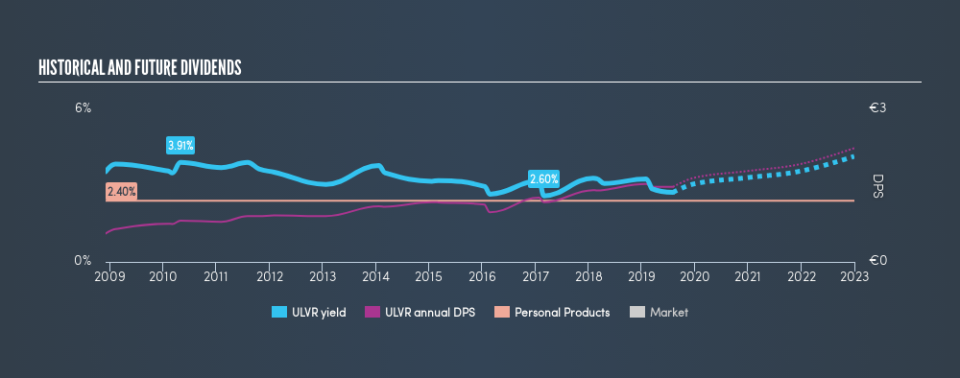Unilever PLC (LON:ULVR)'s Could Be A Buy For Its Upcoming Dividend

It looks like Unilever PLC (LON:ULVR) is about to go ex-dividend in the next 3 days. If you purchase the stock on or after the 8th of August, you won't be eligible to receive this dividend, when it is paid on the 11th of September.
Unilever's next dividend payment will be €0.37 per share, and in the last 12 months, the company paid a total of €1.48 per share. Calculating the last year's worth of payments shows that Unilever has a trailing yield of 2.7% on the current share price of £49.395. If you buy this business for its dividend, you should have an idea of whether Unilever's dividend is reliable and sustainable. We need to see whether the dividend is covered by earnings and if it's growing.
View our latest analysis for Unilever
Dividends are usually paid out of company profits, so if a company pays out more than it earned then its dividend is usually at greater risk of being cut. That's why it's good to see Unilever paying out a modest 43% of its earnings. Yet cash flows are even more important than profits for assessing a dividend, so we need to see if the company generated enough cash to pay its distribution. Over the last year, it paid out more than three-quarters (85%) of its free cash flow generated, which is fairly high and may be starting to limit reinvestment in the business.
It's encouraging to see that the dividend is covered by both profit and cash flow. This generally suggests the dividend is sustainable, as long as earnings don't drop precipitously.
Click here to see the company's payout ratio, plus analyst estimates of its future dividends.
Have Earnings And Dividends Been Growing?
Businesses with strong growth prospects usually make the best dividend payers, because it's easier to grow dividends when earnings per share are improving. Investors love dividends, so if earnings fall and the dividend is reduced, expect a stock to be sold off heavily at the same time. Fortunately for readers, Unilever's earnings per share have been growing at 16% a year for the past five years. The company paid out most of its earnings as dividends over the last year, even though business is booming and earnings per share are growing rapidly. Higher earnings generally bode well for growing dividends, although with seemingly strong growth prospects we'd wonder why management are not reinvesting more in the business.
Many investors will assess a company's dividend performance by evaluating how much the dividend payments have changed over time. Unilever has delivered an average of 10% per year annual increase in its dividend, based on the past 10 years of dividend payments. It's exciting to see that both earnings and dividends per share have grown rapidly over the past few years.
Final Takeaway
Has Unilever got what it takes to maintain its dividend payments? Earnings per share have grown at a nice rate in recent times and over the last year, Unilever paid out less than half its earnings and a bit over half its free cash flow. There's a lot to like about Unilever, and we would prioritise taking a closer look at it.
Wondering what the future holds for Unilever? See what the 15 analysts we track are forecasting, with this visualisation of its historical and future estimated earnings and cash flow
A common investment mistake is buying the first interesting stock you see. Here you can find a list of promising dividend stocks with a greater than 2% yield and an upcoming dividend.
We aim to bring you long-term focused research analysis driven by fundamental data. Note that our analysis may not factor in the latest price-sensitive company announcements or qualitative material.
If you spot an error that warrants correction, please contact the editor at editorial-team@simplywallst.com. This article by Simply Wall St is general in nature. It does not constitute a recommendation to buy or sell any stock, and does not take account of your objectives, or your financial situation. Simply Wall St has no position in the stocks mentioned. Thank you for reading.

 Yahoo Finance
Yahoo Finance 
